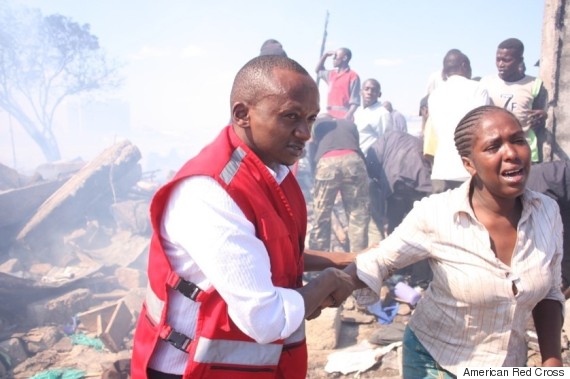Do you know how many homes in the United States have smoke detectors? What about around the world? Can you imagine living in a home that didn't, and going to work in the morning with your child or pet in that house? This is the situation that many around the world face and Red Cross volunteers are working to correct.
Last month, volunteers in Arizona, Tennessee and virtually every other state in the nation walked door-to-door, helping families install and test smoke alarms as part of the American Red Cross Home Fire Preparedness Campaign. More than 9,000 miles away, Red Cross volunteers are now providing a similar lifesaving service in the slums of Nairobi and Cape Town.
Over the past year, as the global technology director or the American Red Cross, I have spent some time with residents of three settlements in Nairobi to better understand the fire risk and help find innovative solutions to this overwhelming problem. When fires occur, residents shout, ring bells, honk horns, crank sirens and use social media to alert others. Some residents risk their lives to suppress the fire using blankets and buckets, others douse their unaffected homes with water and sand or knock them down to stop the spread.

It's challenging to estimate how many slum fires these cities experience each year since so many go unreported, but these fires regularly occur because people are cooking with open flames indoors, overextending faulty wires or trying to keep warm (you can see more details about these occurrences on the Kenya Red Cross Twitter stream). Rapid and haphazard community development has also forced homes dangerously close together, and once they start, fires spread easily throughout the settlement.
On top of this, the density of the slums makes evacuations chaotic and dangerous. Pathways between homes are narrow and often blocked. Imagine a large-scale labyrinth with limited visibility and dozens of obstacles in your way. Getting out of your home when a fire starts and to a safe location within two minutes, as firefighters recommend, is nearly impossible.
Most of the people I meet don't know who to call for help. And professional firefighters, if they are even available, have a difficult time finding homes quickly. Within minutes, hundreds of residents can be left devastated and homeless.

Very few have insurance. And after a fire, forced eviction or rent increases are common. Many end up leaving their communities and families are separated for prolonged periods of time.
Despite the sobering realities of the slums, I still found it easy to stay optimistic. The creativity and entrepreneurial spirit of the local residents is without equal, and together, we have identified an emerging technology tool to complement the Red Cross' current risk reduction programs -- low cost fire sensors that are networked to each other.
An Emerging Technology Solution
This month, we will begin installing two types of simple, yet sophisticated fire sensors, including one manufactured in South Africa, to detect fires earlier, distinguish between smoke and flames, and sound alarms. In the future, we hope to expand the network so they could also directly notify professional firefighters. In the meantime, Red Cross volunteers, who live in these communities and are often the first to respond to fires, will receive real-time notification and GPS data for the location of the fires so they can quickly offer assistance.

To learn more about the Red Cross innovation initiative and the other emerging technology projects planned this year, visit www.tech4resilience.org for regular updates on our progress and read our Vision for the Humanitarian Use of Emerging Technology for Emerging Needs.
The American Red Cross is a partner of Cisco CSR. Cisco sponsors The Huffington Post's ImpactX section.